So you want to buy a sewing machine…Buying your first sewing machine can seem like a huge step. There are so many different sewing machines out there and price points of $30 to $10,000, it’s easy to get overwhelmed.This step-by-step sewing machine buying guide will push away the unnecessary marketing hype of sewing machine buying and dial you into the functions, features, and differences that matter. If you don’t know how to sew yet, you might want to sign-up for notifications about my Zero-to-Sew course. It’s designed for the total beginner.
Even if this is not your first sewing machine, or if you are buying for someone else, follow along I’ll simplify the whole process of buying a sewing machine, and help you prioritize the features that are right for you. This Sewing Machine Buying Guide is a very in depth post. Looking for something a bit lighter? Then read “Choose your new sewing machine in the next 5 Minutes” instead.
Are you already freaking out? Take a deep breath and then download my “Sewing Machine Buying Guide Workbook”. It walks you through picking what features are important to you and has a great spreadsheet to track the sewing machines that you look at when shopping. Organization always makes me feel calmer.
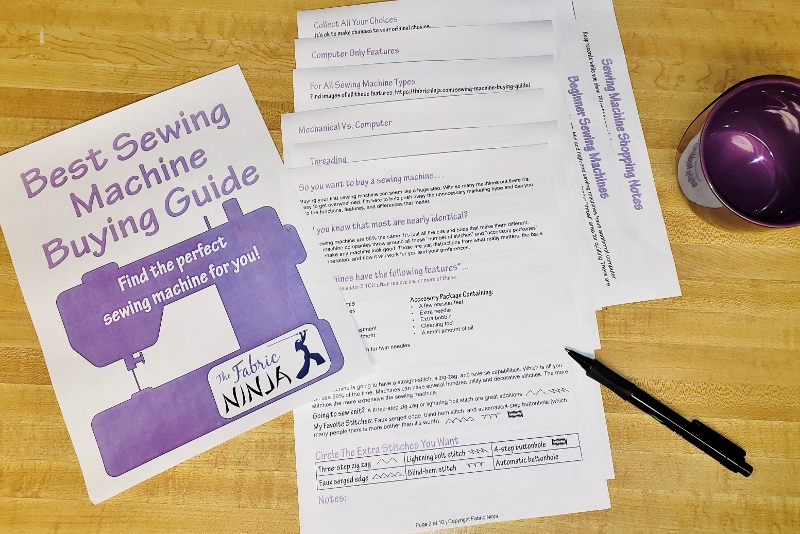
Not That Many Differences
Did you know that most sewing machines are nearly identical? It’s just all the bits and bobs that make them different. You don’t need to worry about what stitches each machine does, or what accessories each machine comes with. Sewing machine companies throw around all these “number of stitches” and “accessory packages” that can make any machine look good. Those are just distractions from what really matters, the base machine operation, and how it will work for you and your preferences.
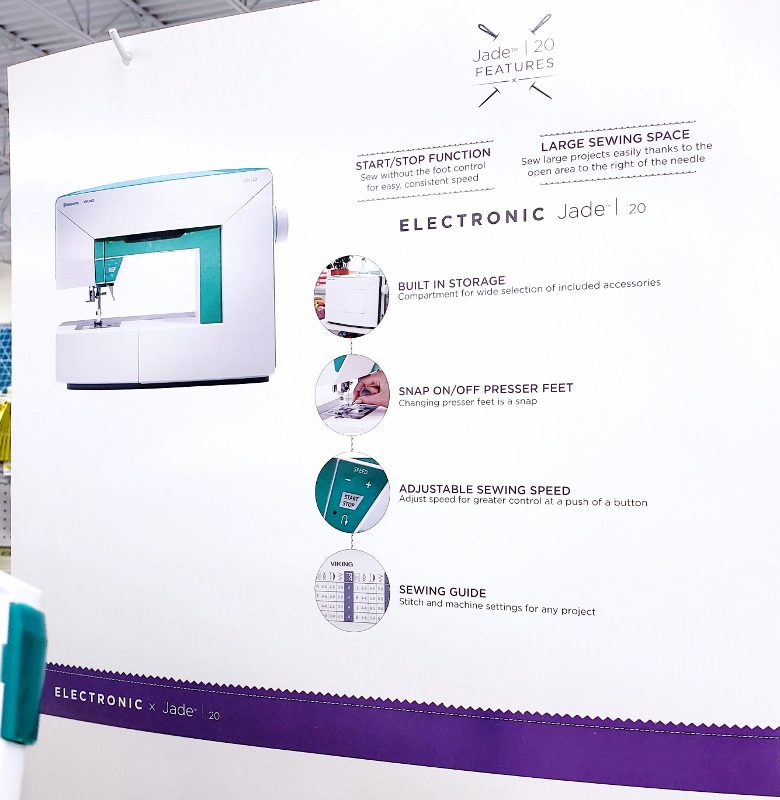
Brand Loyalty
There are a lot of sewing machine companies out there and everyone has their favorite, which is likely the machine that they started using. No matter the brand they’re likely to be loyal to it. You can go into any sewing group and ask everyone’s “favorite sewing machine” and it’s likely to be something different.
People like what they’re used to using. I am not immune to this, but I am not at all brand loyal, so I have a unique perspective that will help you find the right machine for you. How little brand loyalty do I have? Here’s the list of machines I have and use regularly:
I learned on a Vintage Singer (no zig-zag) and then a Brother VX-810. I use a Pfaff 7550 daily. My classroom machines are Eversewn 15. My serger is a Toyota(!), I have a vintage Babylock serger too. My industrial sewing machine is a Singer, and I also have a Singer Featherweight, neither of which I use enough. I used an Elna in high school home economics, and a Bernina in college design classes. My best friend has a Janome, and I like sewing on it too. I am not brand loyal, I’m feature loyal.

Being brand loyal is not entirely a bad thing though, because most sewing machine companies have a wide range of sewing machines at different price points that include different features. The thing that stays the same is the layout. If you don’t like how the front panel is laid out on the low-end machine then you probably won’t like the top of the line machine. If you love where the presser foot lift is on (insert brand name) mid-range machine, it’s going to be in the same place on the high and low end models.
What’s Better?
Being loyal to one company doesn’t limit your ability to getting a “better” sewing machine when you’re ready and sticking with the same brand means that things will be where you are used to them being. Meaning a much lower learning curve. Likewise, if you hate sewing on a $6K Viking, Pfaff, or Bernina, you’re going to hate sewing on the lowest-price model.
This word “better”… it’s kind of a loaded word. The bottom of the line sewing machine that sews a nice stitch and stays in tune is just as good as any top of the line most expensive sewing machine. Neither is better than the other, if they both do exactly what you want. So, “better” can mean better quality and more features, it can mean faster, or it can mean better suited for what you make. Just keep that in mind as you think about what you want. Two Singer Heavy Duty sewing machines below are identical except for the number of stitches.
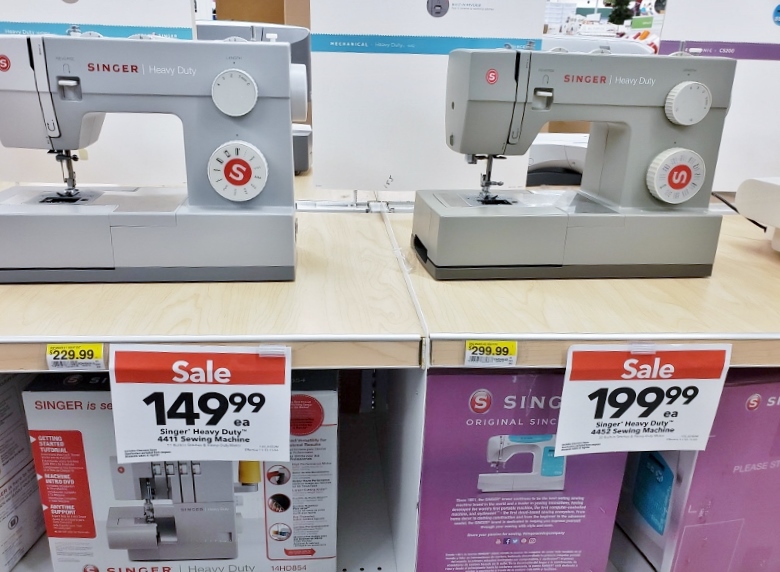
Similarities & Differences
Threading
The upper part of most machines thread almost identically, so that’s not really a consideration when it comes to a standard sewing machine. Newer machines will have arrows and numbers to help you know what order to thread it in. Vintage machines may have both, but it is less common.

The Bobbin (bottom)
The biggest difference in threading happens on the bottom. If you’re not familiar with how a sewing machine works, the bobbin is the thread that is on the bottom side of machine/fabric. Thread goes around a very small spool called a bobbin.
Bobbins come in two styles. Drop-In (also called top loading) and the Front-Loading bobbin (also called bottom loading). I totally wish there were not two names for these, as it make it harder for beginners. Throughout this guide, I’m always going to refer to them as Drop-In and Front-Loading.
A Drop-In bobbin, goes into the machine from the top of the sewing area. Your machine will have a little clear window or panel that you remove in front of the needle area. The filled bobbin is placed into this area and then you slide the tail into the proper place. Some modern machines, particularly those made by Brother, have a little maze with arrows that gets the thread into the perfect position.
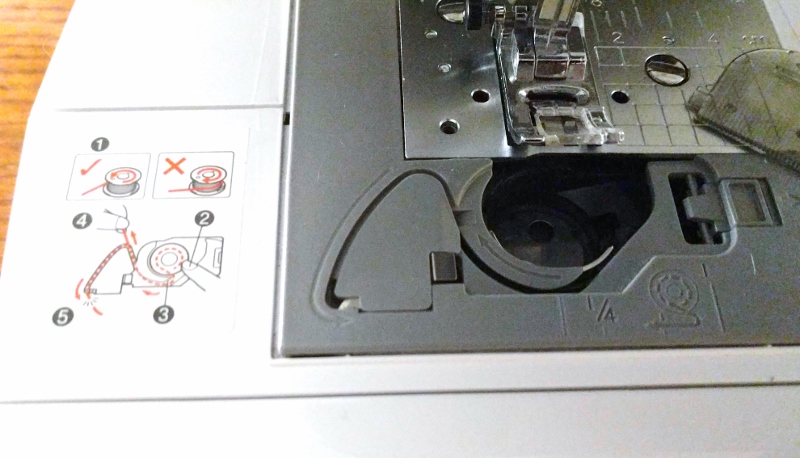
With a Front-Loading bobbin, you open a door on the front of the sewing machine below the needle area. Insert the filled bobbin into the bobbin case and pull the thread through a small groove. You then put the bobbin case back into the machine while keeping it aligned properly.
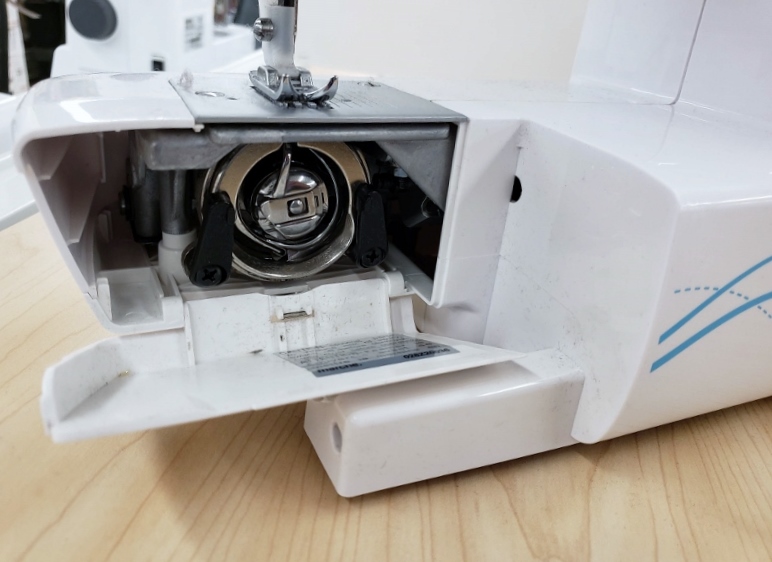
From just reading those two descriptions, you have probably already decided that a drop-in bobbin is going to be easier for you, but I ask you to keep an open mind for a moment longer. What I say next may change your mind.
Personally I prefer front loading bobbins. The sewing machine that I learned to sew to on happened to have a front loading bobbin, so it is what I consider normal and easy. See, it all goes back to what we learned on. Not only, is it what I’m used to; front loading bobbins are easier to adjust the tension on too. If you plan on using very thick thread (upholstery) or elastic thread, you will love the how easy it is to make tension adjustments. I also think they are easier to clean and oil, but again perhaps it’s just what I am used to.

If I step back and look at it, I think for beginners a drop-in bobbin is probably slightly easier. It also removes a lot of the desire to tinker, and perhaps mess up the tension of the bobbin (which is also easy to fix). It works great for almost all thread types. However, if you plan to sewing things with very thick fabric and thick strong thread, you will need to learn a few tricks about getting this thick bobbin thread to go in correctly. If you do need to adjust the bobbin tension (not needed for normal thread), you will need to open up the machine.
Now don’t let “open up the machine” freak you out. Sewing machines are designed to be opened up. One or two screws removed will get you access to the whole bobbin area for cleaning, oiling, and tension adjustment (for a drop in bobbin).
Decision time… Do you want a Drop-In Bobbin or Front-Loading bobbin?
Take a moment to write down your preference. You can download a Sewing Machine Buying Guide worksheet to help you!
More Similarities
All machines above the “budget” models will have the following features.
- Multiple stitches
- Straight stitch
- Zig-zag
- Stitch length adjustment
- Stitch width adjustment
- Movable needle
- Secondary spool pin for twin needles
And a small accessory package containing:
- Presser feet
- Needle
- Extra bobbins
- Cleaning tool
- A small amount of oil
Big Box “Budget” Machines
For the sake of definition, I am going to classify sewing machines that cost less than $100 and can be purchased from a big-box store as budget machines. These machines can be classified as disposable. It will cost more to service them, than to buy a new one. Sometimes they don’t even sew, as they were never checked before leaving the factory. Basic features are removed to make them less expensive and quicker to make. They don’t come with any support or training (often offered at dealerships) and warranties are short and often have lots of exceptions.
I think it is obvious, but I don’t suggest you buy one of these. Not even for a little kid learning. Especially for a kid learning! Kids and beginners are hard on machines. A budget machine will be more frustration that it is worth. When in doubt read the reviews, check the number of stars, and ask in a sewing Facebook group, like mine.
Budget Worthy Machines
Can’t spend over $100? Don’t worry! You are not out of luck. Buy a second-hand machine at a sewing machine dealer/repair shop. They have “abandoned machines” or trade-ins that are freshly serviced and ready to go.
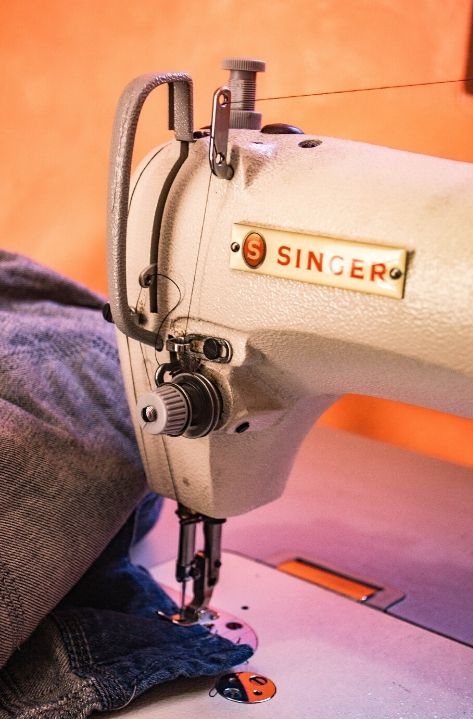
If you already know the machine you want, or at least the features you want, look on Facebook Marketplace or Craigslist. Make sure you are familiar with the machine you are going to buy and see it working before you exchange money. Goodwill stores also are great places to find sewing machines. They will let you plug it in and test that it works, just don’t run it long, as it surely needs oil. Second hand sewing machines from non-repair/dealerships should probably be serviced before use.
A new sewing machine from a dealer is not for everyone, but if you can buy from a dealer they often throw in larger accessory packages, classes, support, and even a free tune up.
Sewing Machine Types
Computer/Mechanical
Some sewing machines come with computers, LCD screens, and buttons that are used to select the stitch type, width, and length. Mechanical machines have dials and knobs that change the stitch type, length, and width. If you are pretty comfortable with technology the computerized machines have the ability to do some really cool things that make sewing easier. For example: A needle up/down button that stops the needle in the chosen position, speed control, and automatic tie-off at the beginning and end of a line of stitching. These features also make computerized machines more expensive. I have a section below with more information about the “Computer/Hybrid Only Features.”
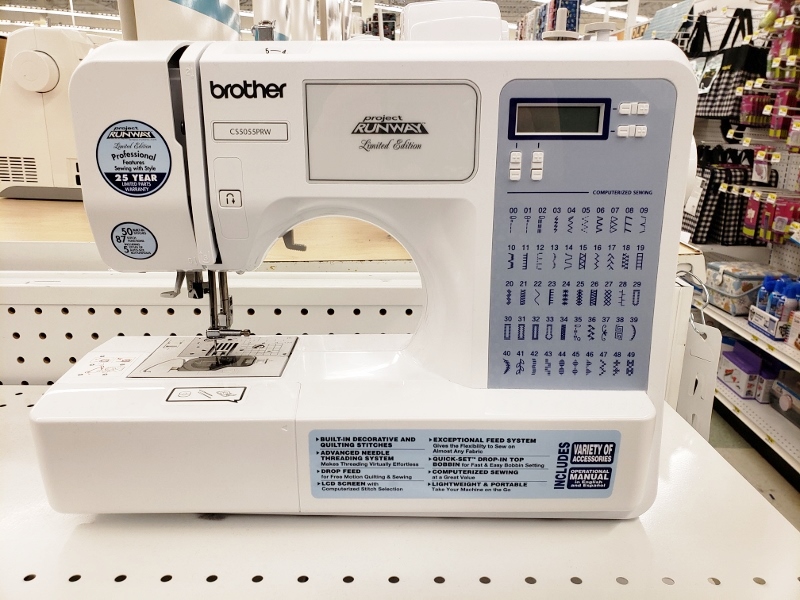
If you have any sort of technology phobia, I suggest that you get a mechanical sewing machine. You don’t need any more reasons or fears that will keep you from taking it out of the box. Mechanical machines also have fewer things to break, no software to update (not all computer machines need updates), and no computer screens to crack. The sewing machines I use to teach sewing classes are the EverSewn Sparrow 15. It has absolutely no computer buttons or screens and also has a front loading bobbin, by the way. My students love it.
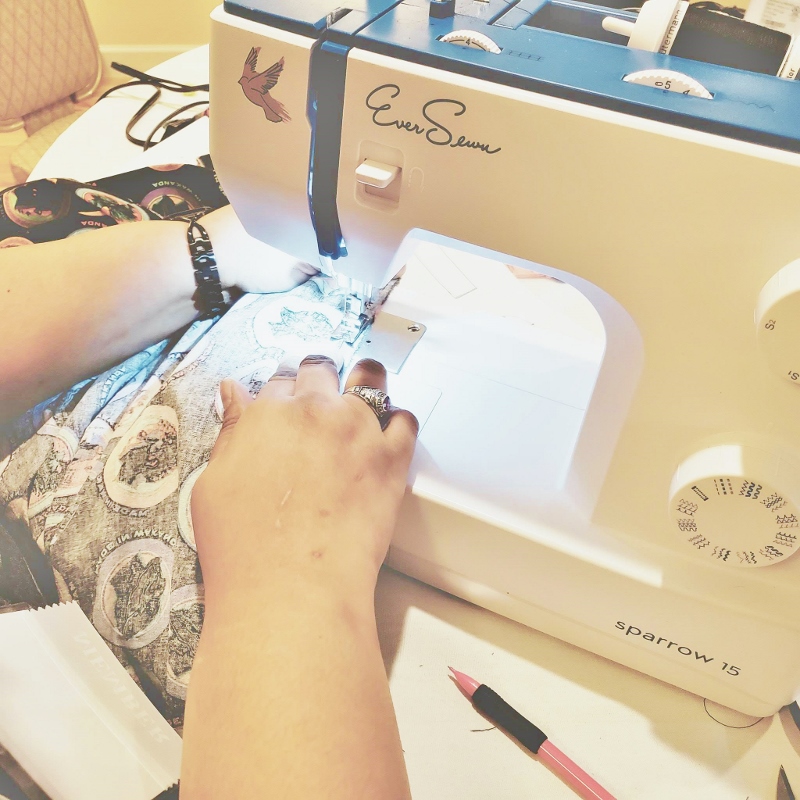
Hybrid:
A few sewing machines out there are a weird hybrid. The next “better” model of the EverSewn Sparrow, for example, starts to incorporate computers, but only in minor ways. The Sparrow 20 is just one step up, is very user friendly, even for those with technology phobia and includes my two favorite of all computer features, needle up/down and speed control (more about those later).

Also the Husqvarna Viking Emerald 118 has speed control, and needle up/down, but otherwise looks like a mechanical machine. Not all higher end machines have a speed control, so watch out if you want this feature. FYI, both the machines I just mentioned have a drop-in bobbin.
Are you starting to feel overwhelmed?
If you are feeling overwhelmed right now go grab a piece of chocolate/cup of coffee, and think about what you want to sew. You probably have all the information you need already. You already know the main differences; you are probably starting to get a feeling for what you want. Remember that Sewing Machine Buying Workbook? Down load it using the form below and fill it out with what you already know.
Don’t have a feeling about what you want?
If you don’t already have a feeling for what features you want, stop reading and get going to a sewing dealership. Or take a sewing class where the sewing machines are provided. Watch YouTube tutorials. Even ask a friend who sews to just tell you about their sewing machine. These will help you start to understand all the things I’m talking about.

Please keep reading if you want to know more about each specific feature, but be aware of “analysis paralysis”. Sure research is good, but there has to be a limit. You won’t totally know what you love and hate about any given sewing machine until you sit in front of it and press that foot.
Decisions are hard…
Don’t want to have to make a decision? I can just tell you to go buy a Eversewn Sparrow 20 or Sparrow 25. I’m pretty sure you will love it.
Still with me on the journey? Let’s keep going…
Let’s learn more about each thing we talked about above. Stitch types, accessories, and feet are covered in the next part. Then I will also talk about an automatic needle threader and free-arm machines, and finally computerized features like needle up/down, start/stop button, and speed control. At the very end there is a small section about weird features you might encounter, like dual feed and knee lifts, before a list of recommended machines with a chart of their features.
Stitches:
We haven’t talked about stitches yet, because this is not the best way to pick a sewing machine. Modern sewing machines, I mean everything from like 1970 forward, are going to have a straight-stitch, a zig-zag, and reverse capabilities. These are basically all anyone really needs to do 80% of sewing. If you’re going to be sewing with knit, you may wish to have a three-step zig zag and a lightning bolt stitch. These are also found on nearly all machines.
The image below is a Singer Start, which I DO NOT recommend because it doesn’t have any stitch width or length adjustment. You can select 3 different lengths of straight stitch on the dial, but no other variations. My point is even a budget machine has the most basic and most useful utility stitches and even a pretty one or two.

Diving into the past (for those that are curious)…reverse and zig-zag are not on all older machines, but reverse happened before zig-zag. Some older machines had a zig-zag attachment just for buttonholes. Their lack of zig-zag is made up for with the most beautiful straight stitch you have ever seen. The Singer Featherweight is a notable example of a machine made for only straight stitch. Returning to the present… Many modern industrial sewing machines also only do straight stitch.
My other favorite stitches are a faux serged edge, blind hem stitch (learn now to make an adorable picot edge – think tiny scallops – with this foot in this blog/video), and an automatic buttonhole (which many people think is more bother than it’s worth).
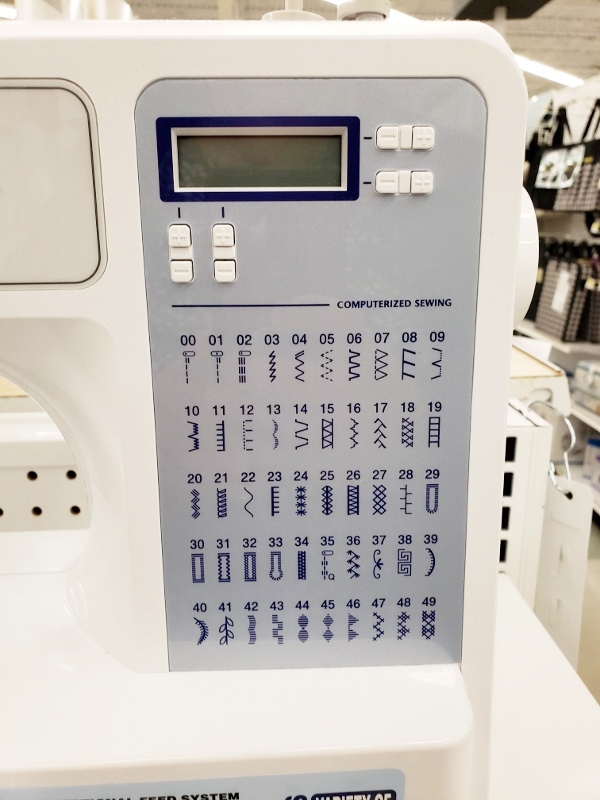
Machines can have several hundred utility and decorative stitches. This is one of the main factors that sewing machine manufactures use to determine the cost. The same machine may have a 30-stitch model and a 60-stitch model, which will cost more. It’s sometimes hard to tell that the number of stitches is the only difference because the body shape or color may change too. So look at the other features first. You may want that machine with 90 decorative stitches, but most people only end up using those five main stitches.
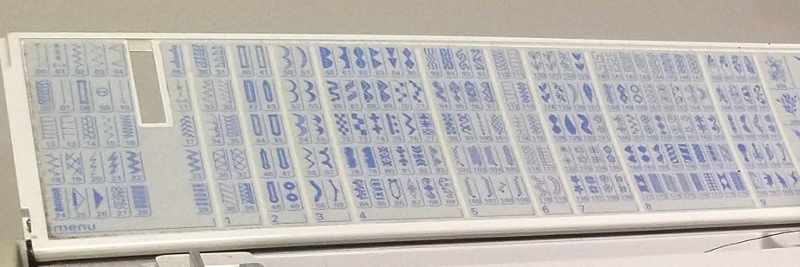
Sewing Feet & Accessories:
New sewing machines come with some useful accessories. These generally include: one or two needles, sewing machine oil, a brush to clean it with, and some feet. The most common feet that are included are a straight stitch foot with a small hole, and a zig-zag stitch with a wider hole, a zipper foot, and a buttonhole foot – if your machine has an automatic buttonhole.

Feet can be made of metal or clear plastic. Replacement feet, and different kinds of feet are available aftermarket. This set of sewing machine feet on Amazon is very popular, and work for most low shank machines. Pfaff is the only exception here, but would work with an aftermarket ankle.
What is a low shank machine?
If you walk into Joann Fabric, every sewing machine on the shelf will be a low shank. So this is not something you have to really think about, but since you asked…
The shank of a sewing machine is the metal rod that a sewing foot is attached to. Sometime, the foot will also be attached to an ankle, and the ankle attaches to the shank. None the less, they come in different sizes and types. Industrial machines are high shank and there are some vintage slant shanks. Home sewing machine, also called domestic machines, have a low shank. So the machine you are 99% likely to buy has a low shank. It’s so common that it is rarely mentioned in sewing manuals.
Options For All Sewing Machine Types
Free-Arm
A free-arm is great for sewing small circles, like cuffs, necklines, and pant hems. These machines generally have an accessory box that comes off the front of the machine. This opens an area under the bobbin to allow for your small items to be sewn in a loop. I love this feature, but I rarely use it or forget I have it when it would be useful. If you sew a lot of clothes, this may be a feature you like.
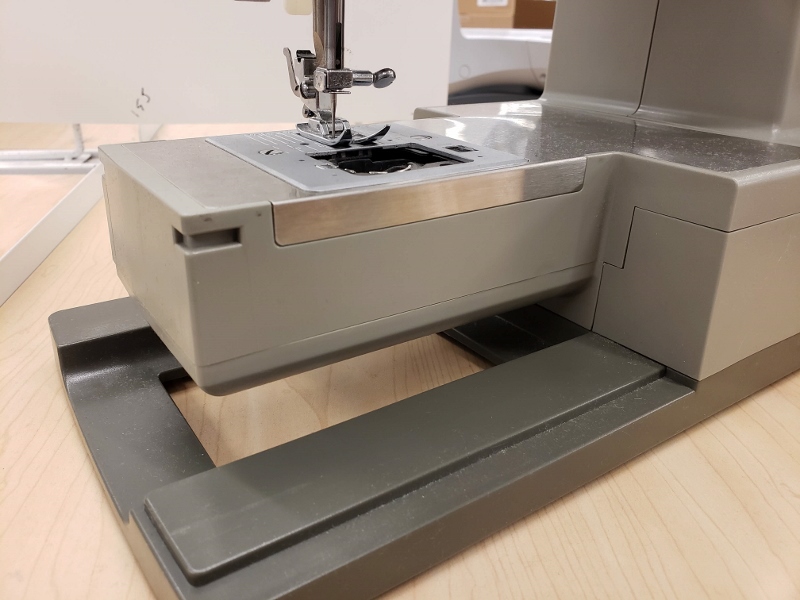
Automatic Needle Threader
Often machines have an automatic needle threader, which is massively enjoyable, although not truly automatic. If your machine does not have this you can buy aftermarket models that you either install on your machine or use in your hand. Your sewing machine manual is your best tool in determining the way to thread your machine, and to find out if you machine has an automatic needle threader. Some lower cost machines even have them.
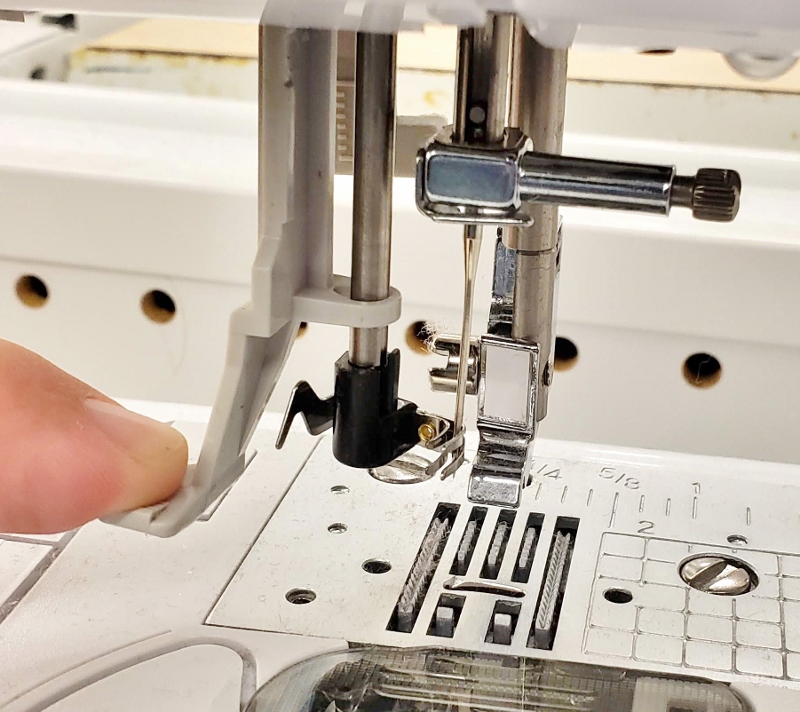
Weight
If you are going to move your machine around a lot, to classes etc. consider how heavy the machine is and does it come with a cover or case. Rolling totes are available aftermarket that fit many machines. Be aware the light machines can also be a bit bouncy as they sew.
Computer / Hybrid Only Features

Variable Speed Control
Many beginners love the variable speed control function. It is a “governor” that doesn’t allow you to go any faster no matter how hard you press the pedal. Generally there are three speeds, so you can work up to sewing faster with time. Not all computerized machines have this feature. I have heard that machines with this feature are generally slower, even on their top speed. However, I haven’t been able to confirm that personally.
Needle Up/Down
Let’s start with some background on how to sew. When you stop a mechanical sewing machine to take out the fabric, you always want to turn the hand wheel (on the side of the machine) toward you, so that the needle is at the very top of its path. This will release the top thread from the bobbin race, and make it possible to pull your fabric out.
Equally so, when you want to turn a corner, you turn the hand wheel so that your needle to the down position which keeps the fabric from moving (it’s stabled by the needle) when you raise the presser foot (the thing that holds the fabric down) and then you turn your project. It will become second nature very quickly.
The needle up/needle down button eliminates this extra step. You touch one button and the needle will always stop up or down. Need it to be in the other position, just poke the button again. It’s seriously my favorite computerized feature. This is my number one reason to get a computerized machine. Even if it barely has any computer features, this is one I LOVE.
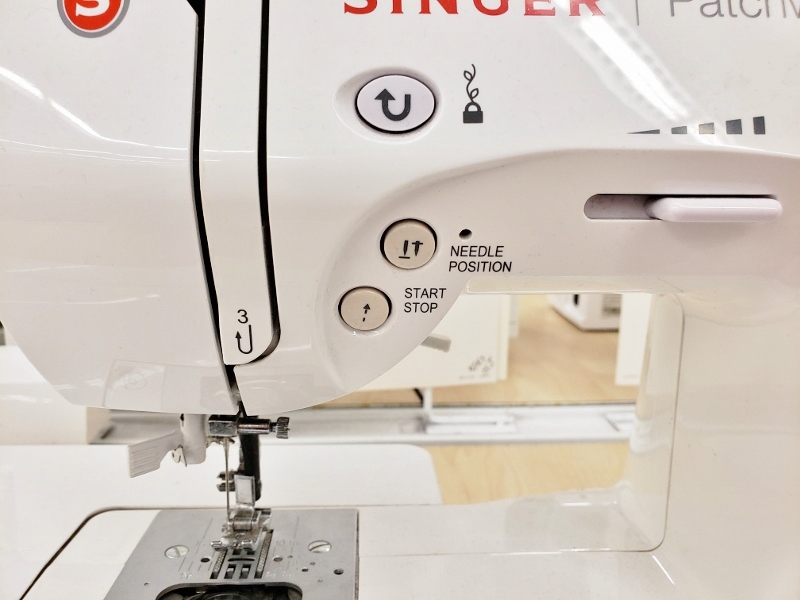
Automatic Tie-Off
When you start and stop a line of stitching, you generally take a few stitches forward and back to tie off the thread so it won’t unravel. Machines with this feature have a button that will do this for you, when you press it. Some machines also have a thread cutting feature too.
Start/Stop Button
Embroidery machines don’t have a control foot, so a button is used to start/stop them. Some manufacturers have decided to add this feature onto regular machines, making it so you can sew without using a foot pedal. This is not a useful feature to me, but I can imagine situations when it might be, such as:
- You do long, mostly straight lines of sewing and don’t want to start and stop much.
- You have a disability where you have limited feeling in your feet.
- You get pain in your feet, knees or hips from sewing.
If you fall into one of those categories, you might really love this feature.
Weird Features?
You may run across these features as you are looking for your new sewing machine. I don’t want them to throw you off your game, so I’ve included them as well.
Dual Feed
Dual feed machines have a little extra bit near the needle that helps pull the top layer of fabric at the same speed as the bottom layer of fabric. The difference in “pull” can be really noticeable when sewing thick projects or very long seams. You can add a walking foot to any sewing machine to get the same results as a dual-feed system. I personally really like machines that have dual feed, my Pfaff has the same concept except it’s called IDT. Having the built in dual feed makes it so I can use all my interesting sewing feet, and still get the benefits of the walking foot.
Sewing machine brands with a dual feed: Pfaff (IDT), Janome (AcuFeed).
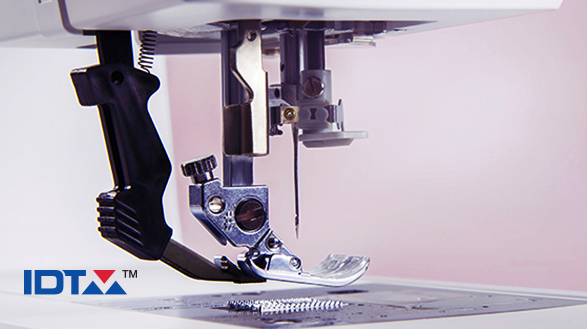
Knee Lifts
Some machines have a knee lift which operates the presser foot, so that both of your hands can be focused on the fabric. This is very common in industrial machines and also in domestic machines designed for quilting. Even if your machine has this feature, you don’t have to use it. The regular presser foot lifter will keep working. Janome is one of the domestic brands known for having this feature.
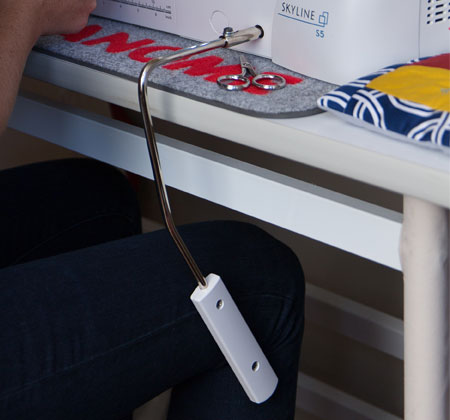
Image from Janome.com
Speed
Sewing machine measure their speed in Stitches Per Minute (SPM). Some machines are specifically high speed. As you get more comfortable sewing, you will also probably like machines that can go faster. The EverSewn Sparrow 15 sews at 750 SPM when the pedal is fully depressed. I find this too slow for me. My students like it and are able to control it well either at full speed or with the foot pedal slowing it down. Not all machines list their speed, but if you want high-speed look for ones that is specifically designed for that, like this Juki.
Dual Purpose Machines
Some sewing machines can also do embroidery. Until you get to very high-end sewing machines, I do not suggest getting a model that does both sewing and embroidery. They are generally not great at either thing. Also embroidery takes a long time and many people like to sew on their other machine while their embroidery machine is working away. It keeps you close by and able to rethread if needed. So in this case “universal” is bad at everything. Uni-taskers are the way to go for sewing, unless you are willing to pay a lot of money. If you want an entry level embroidery machine you can’t beat the Brother PE800 update of the popular PE770.
Metal vs. Plastic Insides
Are Metal Parts Important? Pretty much all non-vintage machines will have plastic on the outside, but you may find a company talking about what’s on the inside, i.e. metal or plastic. The insides of a machine, which are not easy to evaluate, will have either plastic parts or metal parts. It may not really matter as much as we have been lead to believe.
Plastic parts
Over time plastic parts heat up and can simply distort out of shape, making the machine unusable. This is generally over a really long time, with sewing for really long sessions causing heat to build up. Parts can often be replaced. Plastic parts will also make a machine lighter weight. Plastic machines are generally cheaper to manufacture and thus come at a lower price point.
Metal parts
Metal parts are known for their long life, staying in tune longer, and their strength when sewing heavy duty materials. They can cost more and are heavier. Vintage machines are a great source for machines that have metal parts at a low price point. If you choose to buy a vintage machine the best thing to do is get it serviced first, or buy one from a sewing machine repair center. They often have sewing machines for sale. By the way: Eversewn has metal parts. I swear I’m not a dealer, I just love them and their price.
If this metric is important to you, you will need to do some research because not all companies mention this detail in their materials. Certainly machines with plastic parts are not going to tout it as a feature. You will need to specifically look for replacement parts for the machine and see if they are plastic or metal.
Need a suggestion?
All companies have low and high end models, with different features. Some companies have a very cheap “budget” entry level machine because they know that people are brand loyal. Those entry level machines often give beginners lots of issues because of their low quality. This is a balancing act that sewing machine companies are trying, to get you to be their forever customer. All the sewing machines listed below are great for beginners. This is just a sample of the machine available.
Would you like this information in a spreadsheet you can take with you shopping? Download the, “Best Sewing Machine Buying Workbook”, from the from below, which includes a worksheet for picking the sewing machine features that you want, sewing machine info spreadsheet, and shopping worksheet.

The links below are Amazon affiliate links. I may receive a commission for qualifying sales. They also include the most up-to-date prices, which is why I’ve included them here. If you don’t know how to sew yet, you might want to sign-up for notifications about my Zero-to-Sew course. It’s designed for the total beginner.
Entry Level – Mechanical $100-$300
Second hand machine from dealership – Various
Eversewn Sparrow 15: Free-Arm & Front-Load Bobbin, 32 Stitches – $150
Singer Heavy Duty: Free-Arm & Drop-in Bobbin, 32 Stitches – $165
Janome Magnolia 7318: Free-arm & Drop-in Bobbin, 18 Stitches – $300
Entry Level – Computerized or Hybrid $150-$300
Brother CS6000i: Speed Control, Needle Up/Down, Start/Stop, Free-Arm, Drop-in Bobbin, 60 Stitches-$149
Janome JW8100: Speed Control, Needle Up/Down, Start/Stop, Free-Arm, Drop-in Bobbin, 100 Stitches-$210 Amazon
Sparrow 20: Speed Control, Needle Up/Down, Start/Stop, Free-Arm, Drop-in Bobbin, 80 Stitches – $279 Amazon
Singer Quantum Stylist 9960: Speed Control, Needle Up/Down, Start/Stop, Free-Arm, Drop-in Bobbin, 600 Stitches – $299
Entry Level – Computerized or Hybrid $300-$400
Brother Designio DZ3000: Speed Control, Needle Up/Down, Start/Stop, Free-Arm, Drop-in Bobbin, 240 Stitches – $310
Sparrow 25: Speed Control, Needle Up/Down, Start/Stop, Free-Arm, Drop-in Bobbin, 197 Stitches – $329
Husqvarna Viking Emerald 118: Speed Control, Needle Up/Down, Free-Arm, Drop-in Bobbin, 18 Stitches -$399 from dealer with lessons and support. Only sold at dealerships.
Want to remember this? Pin this Sewing Machine Buying guide to Pinterest!
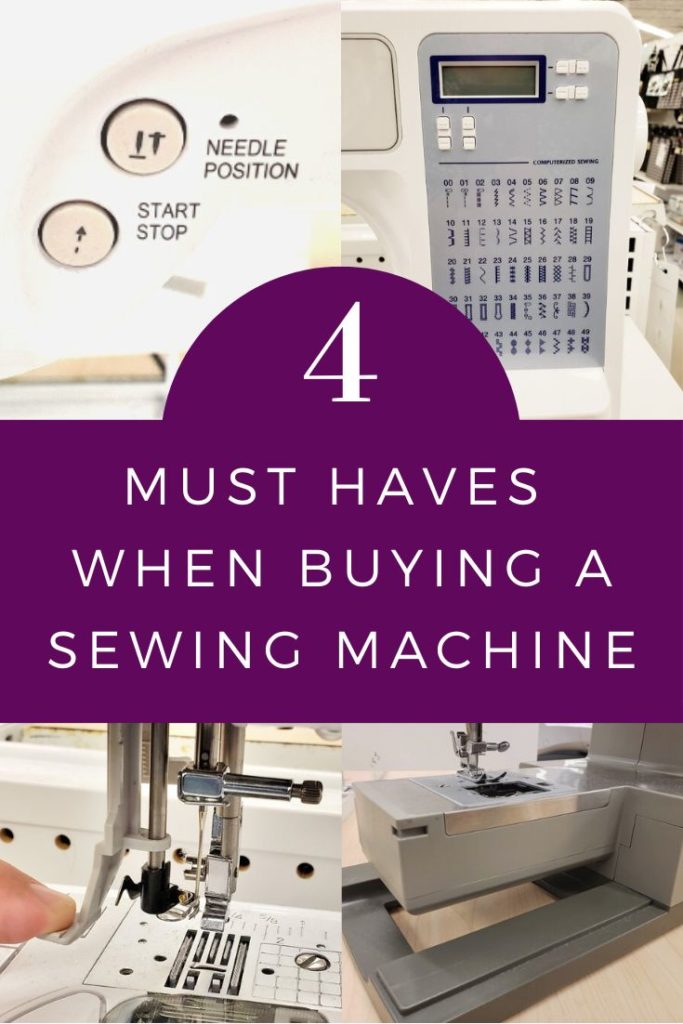
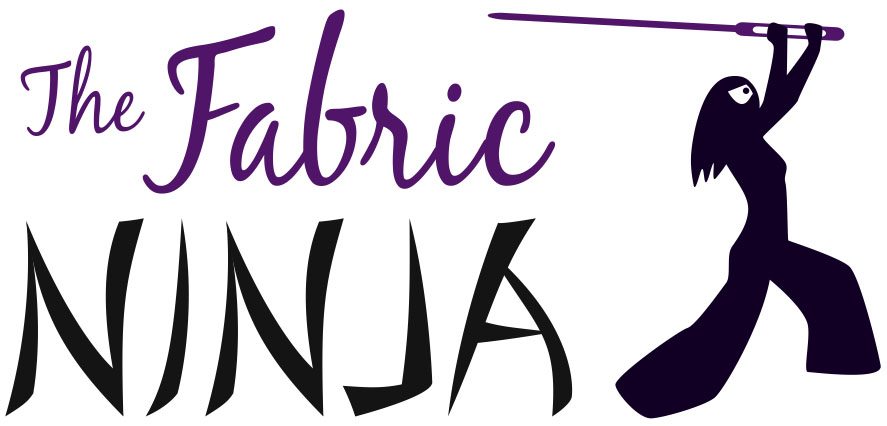
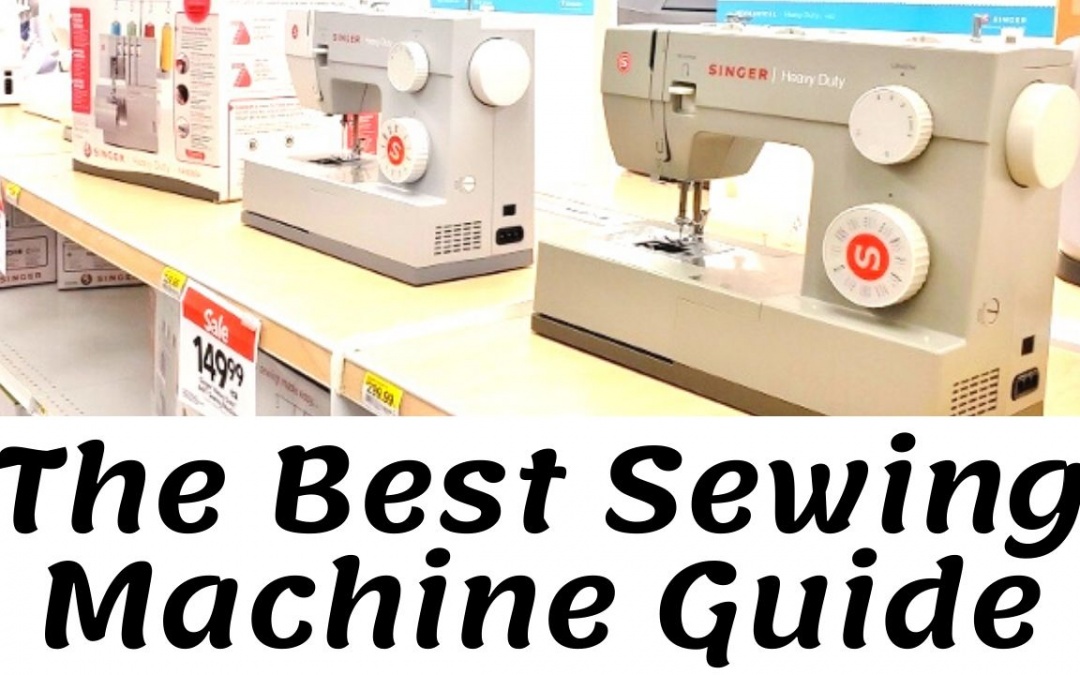
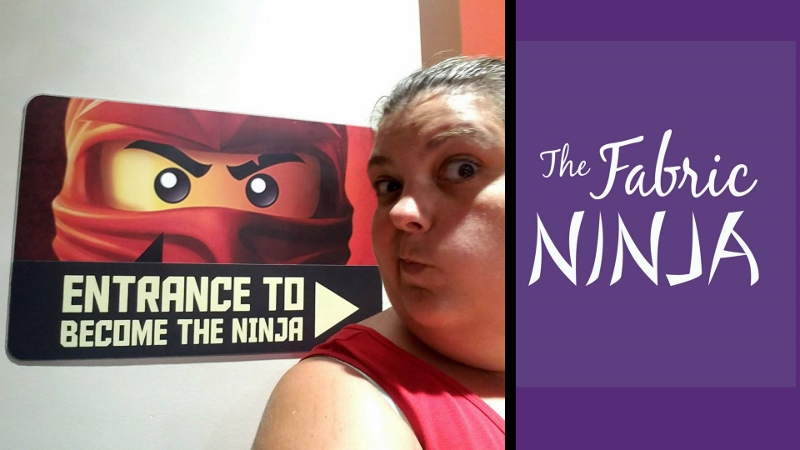
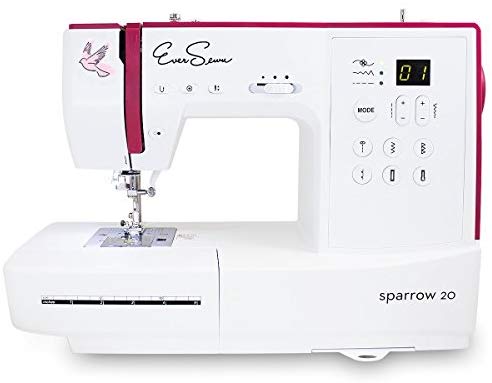
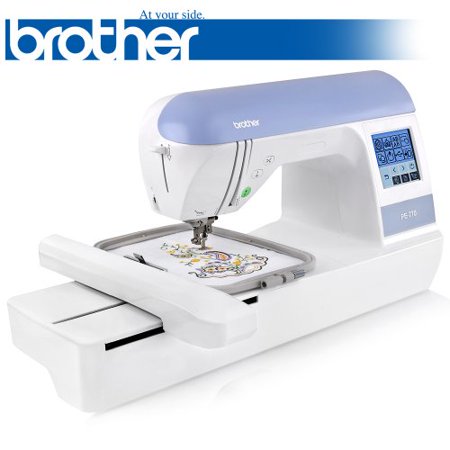
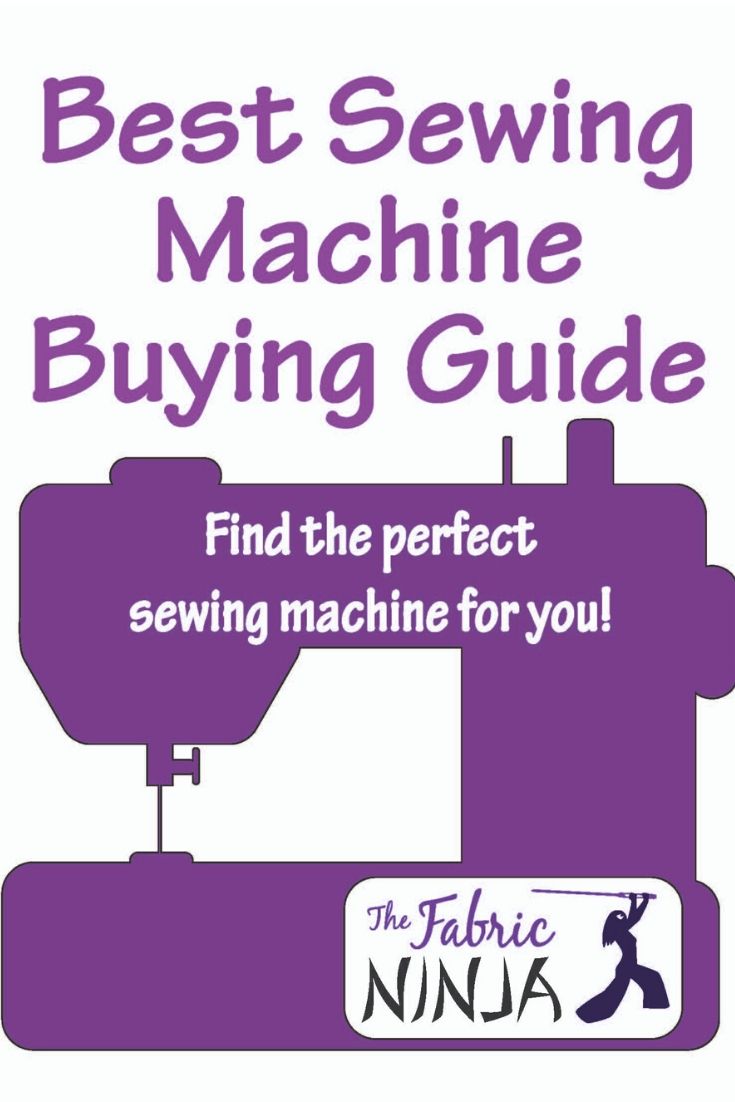
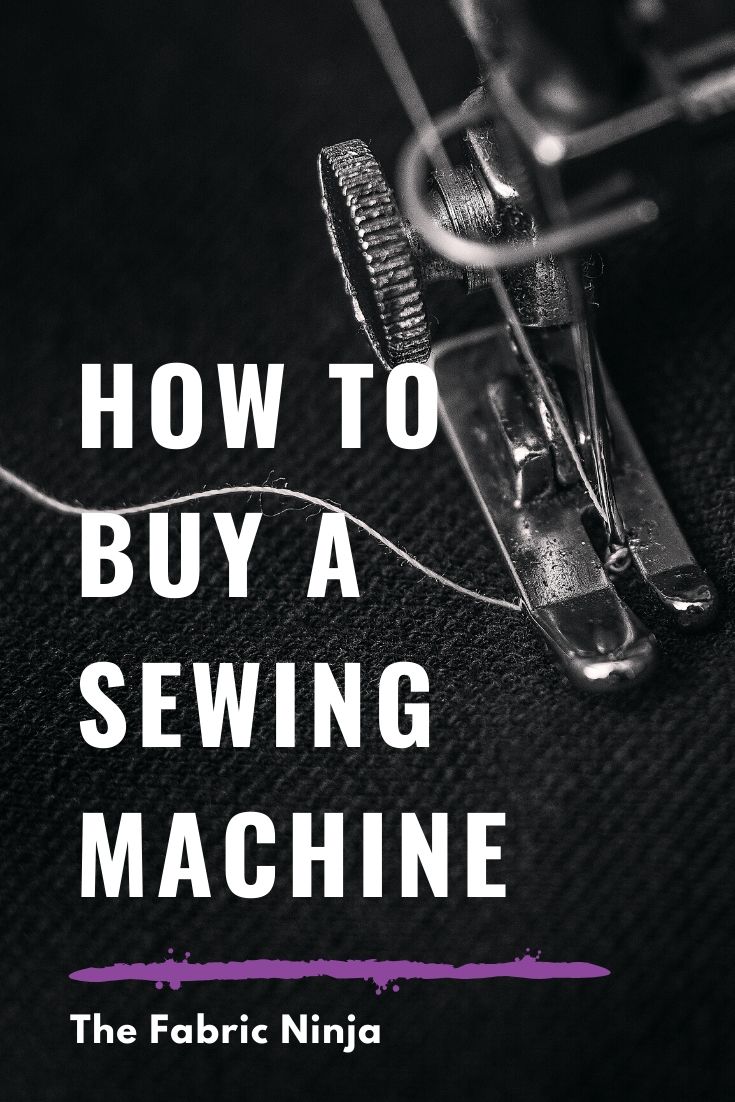
Love my Pfaff 7570. It’s the best machine that I have used in my 50+ years of sewing. I preferr it to my Janome Horizon 7700 which was more expensive.
Great INFO thankX
I just inherited my late Mother’s 1950’s Singer heavy duty 306w machine so I’m learning and your info has helped a lot.
I just found I can make an easy bobbin case alteration to allow common needles to be used in it. http://andrewcaddle.com/wordpress/
Take care
A great article packed with good advice. Like you I prefer a front loading bobbin but they are becoming a thing of the past unless you can really splash the cash which I can’t!
Great post. I was checking constantly this blog and I’m impressed!
Extremely useful info specially the last pwrt 🙂 I care forr such information a
lot. I was looking for this particular information for a very long time.
Thank you and good luck.
Hi there, I enjoy reading all of your article.
I wanted to write a little comment tto support you.
Have a look at my blog post: http://interzoneorganic1.com/ – interzoneorganic1.com –
Hello, just wanted to tell you, I loved this
article. It was helpful. Keep on posting!